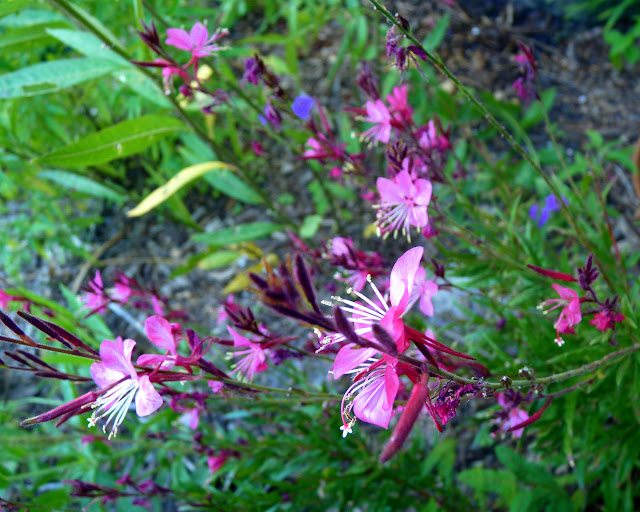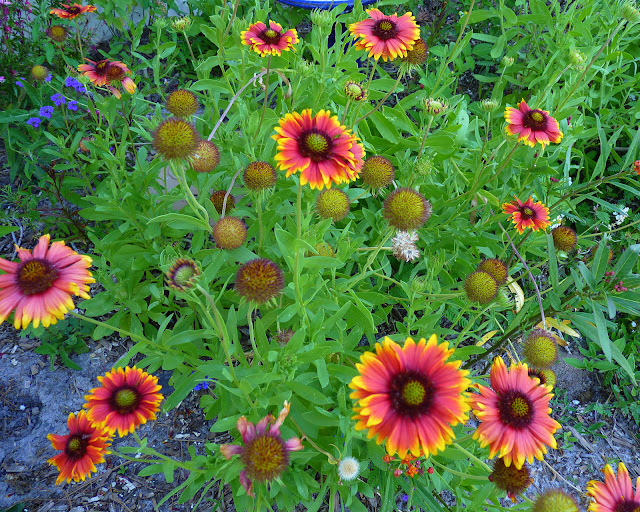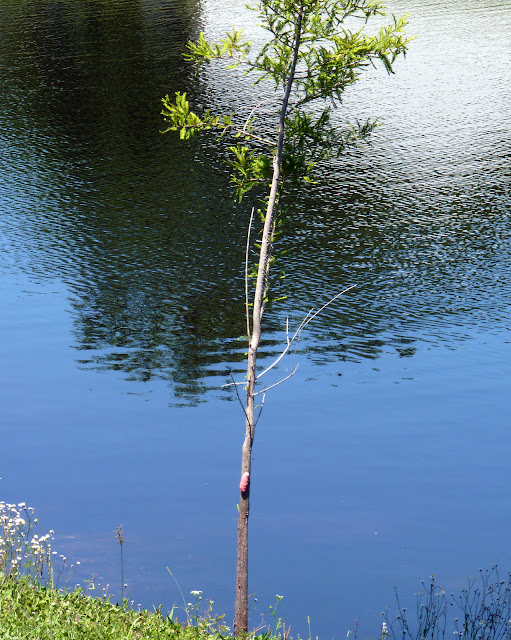Though My Florida Backyard hasn't seen rain in several weeks, there has been rain in the area, taunting us from a distance. The other night, a line of storms about twenty miles away to the east gave us a spectacular light show. Starting around dusk, and continuing for at least an hour, the massive clouds were nearly constantly aglow with electricity; at the peak, we estimated 50 to 100 flashes per minute. Though it takes a better camera than the one we have to truly get good lightning pictures, we gave it a shot, and got a few we thought worth sharing.
The storms were so far we away that we heard only the very faintest rumbles of thunder from time to time, and mostly the show unfolded in the quiet of a summer evening. We only hope that future storms come a little closer and bring us the rain that My Florida Backyard so desperately needs.
An online journal of our quest to make a tiny piece of Florida suburbia into a wildlife-friendly oasis.
Saturday, May 28, 2011
Thursday, May 26, 2011
Blueberry Kisses
Back in January, when we spent some time dreaming over seed catalogs, one of the new blooms that caught our eye was Vinca 'First Kiss Blueberry'. Park Seed offered this deep purple-blue version of one of our favorite annuals, and we decided it was worth a try.
Our results haven't been too bad, and the color itself matches the advertised picture pretty well, although the bloom fades a bit after a few days. We started 10 seeds around the middle of February, and 5 of them sprouted well (it took nearly 30 days) and grew into healthy plants. They started to bloom about two weeks ago, and we're hoping the plants will become bushier and covered with more blooms, as vincas usually do once they get well established.
We're keeping them in a planter on the porch for now while they get stronger and more vigorous, though we may eventually plant them outside. Vincas are wonderfully hardy once they get going - once their root systems get established, they weather heat and drought without blinking an eye. They also tend to re-seed pretty readily, so we're hoping to gather some seed from these vincas and grow more of this wonderful color to spread around My Florida Backyard in the future.
Our results haven't been too bad, and the color itself matches the advertised picture pretty well, although the bloom fades a bit after a few days. We started 10 seeds around the middle of February, and 5 of them sprouted well (it took nearly 30 days) and grew into healthy plants. They started to bloom about two weeks ago, and we're hoping the plants will become bushier and covered with more blooms, as vincas usually do once they get well established.
We're keeping them in a planter on the porch for now while they get stronger and more vigorous, though we may eventually plant them outside. Vincas are wonderfully hardy once they get going - once their root systems get established, they weather heat and drought without blinking an eye. They also tend to re-seed pretty readily, so we're hoping to gather some seed from these vincas and grow more of this wonderful color to spread around My Florida Backyard in the future.
Tuesday, May 24, 2011
American Beauty
It's no secret that one of our favorite native shrubs is the American Beautyberry (Callicarpa americana). Although it's deciduous, it's an interesting plant every day of the year. The berries that appear in fall stay with the bush through the leafless days of winter (at least until the birds eat them), and when the soft green leaves appear in the spring, the delicate pink blooms won't be far behind.
Most people are familiar with the purple-berried version of C. americana, but on a recent trip to Wilcox Nursery in Largo, we found the white-berried version at last, and we snapped one up to add to our Beautyberry hedge. At this time of year, the leaves and flowers look exactly the same, but we look forward to seeing the white berries mixed with the purple when fall arrives.
If you're new to American Beautyberry, check out some of our previous posts to learn more. If you're already a Beautyberry lover and you don't have the white-berried version yet, check with Wilcox or your local native plant nursery to see if they have any in stock. We're very glad to have one at last in My Florida Backyard!
Most people are familiar with the purple-berried version of C. americana, but on a recent trip to Wilcox Nursery in Largo, we found the white-berried version at last, and we snapped one up to add to our Beautyberry hedge. At this time of year, the leaves and flowers look exactly the same, but we look forward to seeing the white berries mixed with the purple when fall arrives.
If you're new to American Beautyberry, check out some of our previous posts to learn more. If you're already a Beautyberry lover and you don't have the white-berried version yet, check with Wilcox or your local native plant nursery to see if they have any in stock. We're very glad to have one at last in My Florida Backyard!
Saturday, May 21, 2011
Mint Condition
This neat little shrub is another of our purchases from Wilcox Nursery last weekend. It's called Georgia Basil or Georgia Calamint (Calamintha georgiana). While it is native to Florida, it's very rare here, found only in a few of the northern counties. It's much more common throughout much of zone 8, including Alabama and Georgia (as you might expect from the name).
Calamint is a member of the Lamiaceae family, which includes culinary herbs like mint and basil. Interestingly, that's exactly what Calamint smells like - a combination of mint and basil. It can be used as seasoning in cooking, or even in making teas.
Practical uses aside, look at these little flowers! Though calamint supposedly blooms only in the fall, ours has one stem covered in blooms right now, and truly it was these little flowers that made us notice the plant in the first place. The flowers themselves are very attractive to bees and smaller butterflies, making it a nice addition to the wildlife garden.
Calamint prefers sandy well-drained soil, and will tolerate full to part sun. Since we live in zone 9b, a little to the south of its common range, we chose to plant it in only part sun, thinking the full sun of summer might be a bit too much for it. It's described as an evergreen, growing to about 2 feet maximum, so it's perfect in the corner of the butterfly garden. We look forward to seeing it this fall when, we've been promised, it will be completely covered in delightful blooms. All in all, a great little native that we're glad to add to My Florida Backyard!
Calamint is a member of the Lamiaceae family, which includes culinary herbs like mint and basil. Interestingly, that's exactly what Calamint smells like - a combination of mint and basil. It can be used as seasoning in cooking, or even in making teas.
Practical uses aside, look at these little flowers! Though calamint supposedly blooms only in the fall, ours has one stem covered in blooms right now, and truly it was these little flowers that made us notice the plant in the first place. The flowers themselves are very attractive to bees and smaller butterflies, making it a nice addition to the wildlife garden.
Calamint prefers sandy well-drained soil, and will tolerate full to part sun. Since we live in zone 9b, a little to the south of its common range, we chose to plant it in only part sun, thinking the full sun of summer might be a bit too much for it. It's described as an evergreen, growing to about 2 feet maximum, so it's perfect in the corner of the butterfly garden. We look forward to seeing it this fall when, we've been promised, it will be completely covered in delightful blooms. All in all, a great little native that we're glad to add to My Florida Backyard!
Tuesday, May 17, 2011
Hot Button
As promised, here is the first of several posts detailing our purchases at Wilcox Nursery this past weekend. First up: Button Sage (Lantana involucrata), a small and terrific native shrub.
Lantana varieties are one of the best butterfly nectar plants out there. Unfortunately, the most common species sold is Lantana camara, which has become invasive in Florida. L. camara quickly escaped cultivation in Florida and has hybridized with our native Lantana depressa to the point that the Florida Association of Native Nurseries no longer recognizes L. depressa as a true native. (See: The Lantana Mess.) That means that Lantana involucrata, known as Button Sage, is the only true Florida native lantana available for sale, and finding it can be a challenge.
Button Sage is common in coastal areas from Central Florida south. It likes well-drained soil and will take full to part sun. It blooms year-round and is hardy to zone 8a, so though it may take a little frost damage in the winter, it should recover quickly and stay green all winter. Like all lantanas, it's drought-tolerant once established but will bloom best with regular water. We planted ours out back near the butterfly garden where it has room to grow and spread, in a mostly sunny spot.
Button sage is a wonderful wildlife plant. The flowers are big nectar draws for butterflies. The subsequent purple berries (how pretty!) are great for songbirds. As a shrub, it provides shelter for smaller creatures as well. All in all, button sage is a must-have for any native wildlife gardener, though it's fairly difficult to find. If you see one, snap it up like we did!
Lantana varieties are one of the best butterfly nectar plants out there. Unfortunately, the most common species sold is Lantana camara, which has become invasive in Florida. L. camara quickly escaped cultivation in Florida and has hybridized with our native Lantana depressa to the point that the Florida Association of Native Nurseries no longer recognizes L. depressa as a true native. (See: The Lantana Mess.) That means that Lantana involucrata, known as Button Sage, is the only true Florida native lantana available for sale, and finding it can be a challenge.
Button Sage is common in coastal areas from Central Florida south. It likes well-drained soil and will take full to part sun. It blooms year-round and is hardy to zone 8a, so though it may take a little frost damage in the winter, it should recover quickly and stay green all winter. Like all lantanas, it's drought-tolerant once established but will bloom best with regular water. We planted ours out back near the butterfly garden where it has room to grow and spread, in a mostly sunny spot.
Button sage is a wonderful wildlife plant. The flowers are big nectar draws for butterflies. The subsequent purple berries (how pretty!) are great for songbirds. As a shrub, it provides shelter for smaller creatures as well. All in all, button sage is a must-have for any native wildlife gardener, though it's fairly difficult to find. If you see one, snap it up like we did!
Sunday, May 15, 2011
Temptation
It was a glorious Sunday afternoon, and we took advantage of the day to drive across to Largo and visit Wilcox Nursery (our very favorite native plant nursery in the Tampa area) to get some muhly grass we'd been wanting for the front yard. Of course, that wasn't the only thing we bought, not by a long shot. Spring is just too tempting of a time to visit a native plant nursery - here's what we ended up coming home with:
Look for detailed posts on these in the days ahead, as we settle our new residents into their places!
- The white-berried variety of American Beautyberry (Callicarpa americana)
- Necklace Pod (Sophora tomentosa)
- Twinflower (Linnaea borealis)
- Button Sage (Lantana involucrata)
- Georgia Calamintha (Calamintha georgiana)
Look for detailed posts on these in the days ahead, as we settle our new residents into their places!
Thursday, May 12, 2011
Things Look Rosy Now
Look who else has been bursting into bloom while we weren't looking! The Gaura lindheimeri has put on dozens of rosy blossoms in the butterfly garden.
Gaura is native to Florida, although this particular variety ('Whirling Butterflies') has been hybridized to create a more compact plant with a greater number of blooms. The wilder gaura is wonderful too, and both have beautiful little flowers to admire up close.
Spring and its seemingly endless parade of new blooms never fails to amaze us in My Florida Backyard!
Gaura is native to Florida, although this particular variety ('Whirling Butterflies') has been hybridized to create a more compact plant with a greater number of blooms. The wilder gaura is wonderful too, and both have beautiful little flowers to admire up close.
Spring and its seemingly endless parade of new blooms never fails to amaze us in My Florida Backyard!
Tuesday, May 10, 2011
In the Queen's Garden
We've been growing more plants from seeds this year in My Florida Backyard, and while our backs were turned, the Queen Red Lime Zinnia began to bloom for the first time!
We started this butterfly-friendly flower from a new seed offered by Burpee this year, and we're pleased to see it's just as lovely as advertised!
Zinnias are one of the easiest flowers to start from seed, and the varieties available these days seem just about endless. We're so glad to have this new variety blooming in My Florida Backyard!
We started this butterfly-friendly flower from a new seed offered by Burpee this year, and we're pleased to see it's just as lovely as advertised!
Zinnias are one of the easiest flowers to start from seed, and the varieties available these days seem just about endless. We're so glad to have this new variety blooming in My Florida Backyard!
Sunday, May 8, 2011
Blanket on the Ground
We've been busy the last week or so... out-of-town guests, busy work schedules, and seemingly dozens of other things conspired to keep us from spending nearly as much time in My Florida Backyard as we would have liked. Fortunately, My Florida Backyard is perfectly capable of surviving and even thriving on benign neglect, and new blooms are popping up everywhere - not the least of which is the Blanket Flower.
Indian Blanket (Gaillardia pulchella) is a wonderful native Florida wildflower. It asks for nothing but soil (sand will do), sun, and the occasional bit of rain, and rewards you with loads of cheery blooms for months on end. Then, it spreads its seeds, ensuring its return for years to come. In fact, all of our Gaillardia come from a single packet of seed we purchased for a couple of bucks a few years ago.
Gaillardia is great for pollinators and a natural in a wildflower garden. You'll often find it along roadsides and in wildflower meadows, and anywhere native flowers are emphasized. It does well in containers and is even salt-tolerant, so it's really perfect just about anywhere in this great state of ours.
Now that we've had a chance to slow down and admire what My Florida Backyard has been up to recently, we look forward to catching up a little more. Look for more posts in the days ahead on what our garden's been doing while we've been looking the other way!
Indian Blanket (Gaillardia pulchella) is a wonderful native Florida wildflower. It asks for nothing but soil (sand will do), sun, and the occasional bit of rain, and rewards you with loads of cheery blooms for months on end. Then, it spreads its seeds, ensuring its return for years to come. In fact, all of our Gaillardia come from a single packet of seed we purchased for a couple of bucks a few years ago.
Gaillardia is great for pollinators and a natural in a wildflower garden. You'll often find it along roadsides and in wildflower meadows, and anywhere native flowers are emphasized. It does well in containers and is even salt-tolerant, so it's really perfect just about anywhere in this great state of ours.
Now that we've had a chance to slow down and admire what My Florida Backyard has been up to recently, we look forward to catching up a little more. Look for more posts in the days ahead on what our garden's been doing while we've been looking the other way!
Sunday, May 1, 2011
Pink Houses
This weekend, a splotch of pink suddenly appeared on the trunk of our little cypress tree.
Upon closer inspection, we discovered a clutch of apple snail eggs.
Apple snails (family Ampullariidae) are freshwater snails that are able to survive both on water and on land. By laying their eggs above the water line, apple snails protect the eggs from predation by fish and other water dwellers.
Apple snails are the primary food source for limpkins, a common wading bird in My Florida Backyard. Limpkins have specially adapted beaks that curve slightly to one side, allowing them to easily extract the apple snail from its shell. Limpkins will only live in areas with large apple snail populations, so they are found only in scattered locations throughout Florida in the United States. We feel very lucky to have this bird as a regular visitor here in our yard, and we owe that to the apple snails and their pretty little pink eggs.
Subscribe to:
Posts (Atom)




























